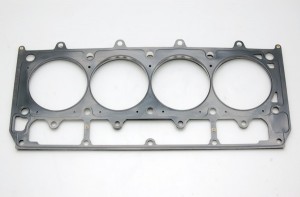 A rule of thumb for performance engine building is that if you are doubling an engine’s power output, or are going much over 550 to 600 hp, you should upgrade to some type of aftermarket performance gaskets. Upgrades usually require no additional modifications. You just swap a performance MLS gasket for the stock head gasket.
A rule of thumb for performance engine building is that if you are doubling an engine’s power output, or are going much over 550 to 600 hp, you should upgrade to some type of aftermarket performance gaskets. Upgrades usually require no additional modifications. You just swap a performance MLS gasket for the stock head gasket.
Composition gaskets can usually handle up to 600 hp or so. Stock MLS gaskets can usually handle more, depending on the applications. But for serious increases in power, you need to upgrade to a purpose-built performance MLS head gasket.
Performance MLS gaskets often feature special embossments, higher temperature coatings and other design innovations for specific engine applications that help them handle higher temperatures and loads. Some of these MLS gaskets use a more gradual radius on their embossments to reduce stress and improve conformability so the gasket will evenly distribute load across the contact area.
Some MLS gaskets destined for performance applications may also undergo a special stress relieving treatment to improve their durability and ability to retain torque.
Most aftermarket gasket suppliers offer some type of MLS head gasket for popular performance applications such as SB/BB Chevy, SB/BB Ford, SB/BB Chrysler, and even some sport compact engines. MLS gaskets have become the “go to” gaskets for racing and street performance engines because they can handle just about anything.
The only exception today is Top Fuel and Blown Alcohol dragsters and funny cars which are still running copper shims and O-rings. But who knows, MLS gaskets may even find a niche here someday.
One manufacturer told us its latest performance MLS gasket (which has four layers and a special laser welded stopper layer) has been successfully used in a 3,300 hp big block Chevy.
Performance Finish

MLS head gaskets are made of several layers of embossed stainless steel (most are 3 or 4 layers thick, but some have more). A thin coating (.001” to .0015”) of nitrile rubber or Viton is used on the external surfaces as well as between the layers to provide maximum sealing.
Most aftermarket MLS gaskets can handle surface finishes as rough as 60 to 70 Ra microinches, but some specify a smoother finish of 30 to 50 Ra. Smoother is always better, and if you can get the finish down to the low teens or even single digit, great! But for most applications, a surface finish in the 20 to 30 Ra range is more than smooth enough for a performance MLS gasket.
If you are building a street performance engine that has a cast iron block and aluminum heads, and are using conventional steel/fiber composite head gaskets or expanded graphite head gaskets, the surface finish should ideally be 60 to 80 Ra (360 to 480 Rz).
Don’t go smoother than 40 Ra (240 Rz) or rougher than 100 Ra (600 Rz) with a composition gasket. Rougher surfaces limit gasket conformance, while smoother surfaces increase the tendency for gaskets to flow, reducing the gaskets blow out resistance.
If you are using a stock MLS head gasket, the surface finish should be 30 Ra (180 Rz) or less unless the MLS gasket has a thicker coating that can seal a rougher surface.
Note: Never apply any kind of sealer to a MLS gasket! It may react with the coating and cause a problem.
Though Ra (Roughness Average) has traditionally been used to describe surface finish, most gasket engineers today say a more accurate perimeter is Rz, which is the average difference between the peak height and valley depth. Ra can have a wide variance across a given surface profile, so Rz gives a better indication of the actual texture across the surface.
Waviness across the surface is also important. The less waviness the better: no more than .0004” with MLS head gaskets. Trouble is, you can’t measure waviness with a profilometer. It takes special (expensive) lab equipment. Waviness problems can be caused by vibrations and a lack of rigidity in milling equipment.
The flatness of the head and block surfaces is also critical in a performance engine. The maximum amount of out-of-flat should not exceed .001” within three inches in any direction in a stock engine, so even less is best for a performance build.
For a V8 engine, the maximum allowable out-of-flat specification for stock cylinder head and block deck surfaces is .004” lengthwise and .002” sideways. Aim for .002” if you’re building a performance engine. For a V6, the recommendation for a stock engine is less than .003” out-of-flat lengthwise and .002” sideways. Again, shoot for half that with a performance build.
As for an in-line six cylinder engine, the stock recommendation is no more than .006” lengthwise and .002” sideways out of flat. If you have .003” or less out-of-flat lengthwise and .001” sideways, you should be in good shape to seal up the head gasket.














